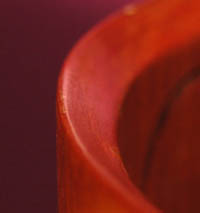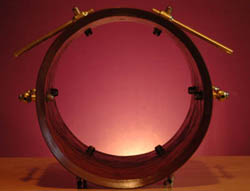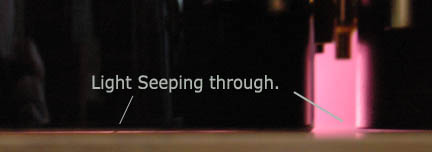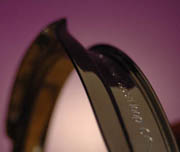Checking the integrity and condition of the drumshell.
Irrespective of the type of drum you are working with, it is always good practise to take the opportunity whilst having the heads off a drum, to give it a health check. Basic checks will look at bearing edges and shell condition as outlined below, however it is also a good idea to look at any hardware mounted to the drum, plus to look at the condition of the wood in the drum and the hoops.
For the purposes of this exercise, we will look at two of those factors which most affect the tunability and sound of the drum, i.e. the bearing edges and the shell.
 Strip the old heads and hoops off the drum to reveal both ends of the shell. The ‘bearing edges’ are the sharpened lips at the top & bottom of the shell over which the head is stretched. This edge normally has a 40-50 degree main angle and is offset toward the outer side of the shell so there is a long diagonal ‘cut’ towards the centre of the drum and a similar but much shorter cut on the outside. Some drum makers have cut a double 45 degree bearing edge with the ‘peak’ in the centre of the shell’s width – they say this is for improved accuracy in tuning and purity of tone. The bearing edge is critical to a drum’s sound as it is the only place on the drum that the head is in direct contact with the shell It forms the boundary of the vibrating membrane and therefore defines the ‘sound’ of that drum to a significant degree.
Strip the old heads and hoops off the drum to reveal both ends of the shell. The ‘bearing edges’ are the sharpened lips at the top & bottom of the shell over which the head is stretched. This edge normally has a 40-50 degree main angle and is offset toward the outer side of the shell so there is a long diagonal ‘cut’ towards the centre of the drum and a similar but much shorter cut on the outside. Some drum makers have cut a double 45 degree bearing edge with the ‘peak’ in the centre of the shell’s width – they say this is for improved accuracy in tuning and purity of tone. The bearing edge is critical to a drum’s sound as it is the only place on the drum that the head is in direct contact with the shell It forms the boundary of the vibrating membrane and therefore defines the ‘sound’ of that drum to a significant degree.
It should go without saying therefore that any untreated flat spots, cuts, nicks or other damage to the edge will become apparent in the tuning process and may be evident through overtones, harmonics, rings, buzzes or general difficulty in obtaining a single pure tone.
The only exception to that rule is by design and is the resonant underside of a snare drum. Snare drums have a ‘snare bed’ cut into the bearing edge, this is a shallow flattened area of the bearing edge indented so that the cable or strip ties can hold the snares tight against the head. Because the snares muffle the head to an extent anyway, overtones are not such a consideration, the snare’s resonant bearing edge is still important but not critical. These ‘beds’ are compensated for in the tuning process and will be discussed in the section on snare tuning. See Ronn Dunnett’s excellent piece on drumdojo.com regarding the snare bed.
The edge should be very definite and sometimes can be felt to be sharp, sharpness will have an obvious fragility. To check for damage, look closely at the edge. run your finger round the edge (try with your eyes closed, it helps), is it smooth & even? If not, then you have a potential tuning problem. Mark the damaged area lightly with chalk or some other non-permanent method and continue checking around the drum
Repairs to bearing edges are either straightforward or not, tiny areas of damage may be ignored, alternatively you could carefully fill & sand the damaged areas. If the edges are more severely damaged you will need to have them re-cut by a master woodworker or a suitably equipped and experienced technician.
If the bearing edges are in acceptable condition, proceed with checking the shell for torsion before embarking on the re-heading process.
When you have checked the bearing edges, place the drum on a surface that you know is level. Plate Glass or polished granite are good. Look all around the drum at the bottom edge where it touches the surface. A ‘true’ drum will touch the surface at all points and you should not be able to see any light coming through. it is surprising how many drums are out of true.

In my experience, this is usually due to the cumulative effects of stress / exposure to heat / moisture, or just a poor quality instrument. Snare drums particularly or any drum where the shell depth is much narrower than the width are particularly prone to this. Torsion is a significant problem to deal with. Re-cutting the top and bottom of the drum and associated re-cutting of bearing edges is a dra stic measure that should be avoided unless you are absolutely convinced it is necessary. For the most part torsion can and probably should be left alone. With the twist across the whole drum you may notice shorter resonance in comparison with the rest of your drums, or a strong harmonic. This can be adapted to in part by the use of flanged hoops which are much more forgiving of shell inconsistencies than die-cast hoops. Sometimes the torsion has no audible effect, either way, consider your options carefully before embarking on an expensive and destructive course of work. Sometimes there are things you just have to live with!
stic measure that should be avoided unless you are absolutely convinced it is necessary. For the most part torsion can and probably should be left alone. With the twist across the whole drum you may notice shorter resonance in comparison with the rest of your drums, or a strong harmonic. This can be adapted to in part by the use of flanged hoops which are much more forgiving of shell inconsistencies than die-cast hoops. Sometimes the torsion has no audible effect, either way, consider your options carefully before embarking on an expensive and destructive course of work. Sometimes there are things you just have to live with!